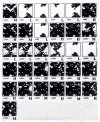Unsupervised Learning in Drug Design from Self-Organization to Deep Chemistry
- PMID: 35269939
- PMCID: PMC8910896
- DOI: 10.3390/ijms23052797
Unsupervised Learning in Drug Design from Self-Organization to Deep Chemistry
Abstract
The availability of computers has brought novel prospects in drug design. Neural networks (NN) were an early tool that cheminformatics tested for converting data into drugs. However, the initial interest faded for almost two decades. The recent success of Deep Learning (DL) has inspired a renaissance of neural networks for their potential application in deep chemistry. DL targets direct data analysis without any human intervention. Although back-propagation NN is the main algorithm in the DL that is currently being used, unsupervised learning can be even more efficient. We review self-organizing maps (SOM) in mapping molecular representations from the 1990s to the current deep chemistry. We discovered the enormous efficiency of SOM not only for features that could be expected by humans, but also for those that are not trivial to human chemists. We reviewed the DL projects in the current literature, especially unsupervised architectures. DL appears to be efficient in pattern recognition (Deep Face) or chess (Deep Blue). However, an efficient deep chemistry is still a matter for the future. This is because the availability of measured property data in chemistry is still limited.
Keywords: deep chemistry; deep learning; drug design; feature engineering; feature learning; molecular representation; self-organizing maps; supervised learning; unsupervised learning.
Conflict of interest statement
The author declares no conflict of interest.
Figures





References
-
- Polanski J. Encyclopedia of Bioinformatics and Computational Biology. Elsevier; Amsterdam, The Netherlands: 2019. Chemoinformatics: From Chemical Art to Chemistry in Silico; pp. 601–618. - DOI
-
- Dreyfus H.L. What Computers Can’t Do—The Limits of Artificial Intelligence. Harper and Row; New York, NY, USA: 1979.
-
- McCarthy What is AI?/Basic Questions. [(accessed on 26 February 2022)]. Available online: http://jmc.stanford.edu/artificial-intelligence/what-is-ai/index.html#:~....
-
- Sutton R.S., Barto A.G. Reinforcement Learning: An Introduction. MIT Press; Cambridge, MA, USA: Cambridge Mass; Cambridge, MA, USA: 2018.
Publication types
MeSH terms
Grants and funding
LinkOut - more resources
Full Text Sources

